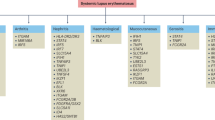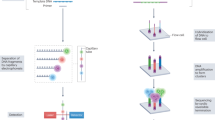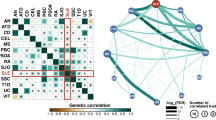Abstract
Staggering advances have been made in our understanding of the genetic basis of human systemic lupus erythematosus (SLE), but has this been sufficient to fulfill early predictions that we could use genetics to provide personalized healthcare? Our current understanding of the genetic etiology of SLE indicates a strong underlying genetic predisposition, mediated by multiple gene variants. Compared with other complex genetic diseases, the disease risk imparted by many of these variants is strong. We argue that, for SLE, this particular combination of genetic effects means that the personalized prediction of disease onset or manifestation is certainly a realistic possibility, although further large-scale genetic studies will be required before this becomes a reality. We speculate that, in the future, genetic information could help guide targeted therapeutic intervention.
This is a preview of subscription content, access via your institution
Access options
Subscribe to this journal
Receive 12 print issues and online access
$209.00 per year
only $17.42 per issue
Buy this article
- Purchase on Springer Link
- Instant access to full article PDF
Prices may be subject to local taxes which are calculated during checkout


Similar content being viewed by others
References
Lander, E. S. et al. Initial sequencing and analysis of the human genome. Nature 409, 860–921 (2001).
Bell, J. The new genetics in clinical practice. BMJ 316, 618–620 (1998).
Hochberg, M. C. The application of genetic epidemiology to systemic lupus erythematosus. J. Rheumatol. 14, 867–869 (1987).
Gateva, V. et al. A large-scale replication study identifies TNIP1, PRDM1, JAZF1, UHRF1BP1 and IL10 as risk loci for systemic lupus erythematosus. Nat. Genet. 41, 1228–1233 (2009).
Graham, R. R. et al. Genetic variants near TNFAIP3 on 6q23 are associated with systemic lupus erythematosus. Nat. Genet. 40, 1059–1061 (2008).
Harley, J. B. et al. Genome-wide association scan in women with systemic lupus erythematosus identifies susceptibility variants in ITGAM, PXK, KIAA1542 and other loci. Nat. Genet. 40, 204–210 (2008).
Hom, G. et al. Association of systemic lupus erythematosus with C8orf13-BLK and ITGAM-ITGAX. N. Engl. J. Med 358, 900–909 (2008).
Rhodes, B. & Vyse, T. J. The genetics of SLE: an update in the light of genome-wide association studies. Rheumatology (Oxford) 47, 1603–1611 (2008).
Rioux, J. D. et al. Mapping of multiple susceptibility variants within the MHC region for 7 immune-mediated diseases. Proc. Natl Acad. Sci. USA 106, 18680–18685 (2009).
Sigurdsson, S. et al. Polymorphisms in the tyrosine kinase 2 and interferon regulatory factor 5 genes are associated with systemic lupus erythematosus. Am. J. Hum. Genet. 76, 528–537 (2005).
Remmers, E. F. et al. STAT4 and the risk of rheumatoid arthritis and systemic lupus erythematosus. N. Engl. J. Med. 357, 977–986 (2007).
Thompson, I. M. et al. Operating characteristics of prostate-specific antigen in men with an initial PSA level of 3.0 ng/ml or lower. JAMA 294, 66–70 (2005).
Dejaco, C. et al. Diagnostic value of antibodies against a modified citrullinated vimentin in rheumatoid arthritis. Arthritis Res. Ther. 8, R119 (2006).
Janssens, A. C. et al. Predictive testing for complex diseases using multiple genes: fact or fiction? Genet. Med. 8, 395–400 (2006).
Janssens, A. C. et al. The impact of genotype frequencies on the clinical validity of genomic profiling for predicting common chronic diseases. Genet. Med. 9, 528–535 (2007).
Bertoli, A. M. & Alarcon, G. S. in Systemic Lupus Erythematosus (eds Tsokos, G. C., Gordon, C. & Smolen, J. S.) 1–18 (Mosby, Philadelphia, 2007).
Tsao, B. P. et al. Familiality and co-occurrence of clinical features of systemic lupus erythematosus. Arthritis Rheum. 46, 2678–2685 (2002).
Wang, W. Y., Barratt, B. J., Clayton, D. G. & Todd, J. A. Genome-wide association studies: theoretical and practical concerns. Nat. Rev. Genet. 6, 109–118 (2005).
Tan, E. M. et al. The 1982 revised criteria for the classification of systemic lupus erythematosus. Arthritis Rheum. 25, 1271–1277 (1982).
Arbuckle, M. R. et al. Development of autoantibodies before the clinical onset of systemic lupus erythematosus. N. Engl. J. Med. 349, 1526–1533 (2003).
Hunnangkul, S. et al. Familial clustering of non-nuclear autoantibodies and C3 and C4 complement components in systemic lupus erythematosus. Arthritis Rheum. 58, 1116–1124 (2008).
Kim-Howard, X. et al. ITGAM coding variant (rs1143679) influences the risk of renal disease, discoid rash, and immunologic manifestations in lupus patients with European ancestry. Ann. Rheum. Dis. doi:10.1136/ard.2009.120543.
Yang, W. et al. ITGAM is associated with disease susceptibility and renal nephritis of systemic lupus erythematosus in Hong Kong Chinese and Thai. Hum. Mol. Genet. 18, 2063–2070 (2009).
Taylor, K. E. et al. Specificity of the STAT4 genetic association for severe disease manifestations of systemic lupus erythematosus. PLoS Genet. 4, e1000084 (2008).
Chung, S. A. et al. European population substructure is associated with mucocutaneous manifestations and autoantibody production in systemic lupus erythematosus. Arthritis Rheum. 60, 2448–2456 (2009).
Richman, I. B. et al. European population substructure correlates with systemic lupus erythematosus endophenotypes in North Americans of European descent. Genes Immun. doi: 10.1038/gene.2009.80.
Graham, R. R., Hom, G., Ortmann, W. & Behrens, T. W. Review of recent genome-wide association scans in lupus. J. Intern. Med. 265, 680–688 (2009).
Moser, K. L., Kelly, J. A., Lessard, C. J. & Harley, J. B. Recent insights into the genetic basis of systemic lupus erythematosus. Genes Immun. 10, 373–379 (2009).
Aringer, M. & Crow, M. K. A bridge between interferon-alpha and tumor necrosis factor in lupus. J. Rheumatol. 35, 1473–1476 (2008).
Aringer, M. et al. Adverse events and efficacy of TNF-alpha blockade with infliximab in patients with systemic lupus erythematosus: long-term follow-up of 13 patients. Rheumatology (Oxford) 48, 1451–1454 (2009).
Favas, C. & Isenberg, D. A. B-cell-depletion therapy in SLE—what are the current prospects for its acceptance? Nat. Rev. Rheumatol. 5, 711–716 (2009).
Yates, C. R. et al. Molecular diagnosis of thiopurine S-methyltransferase deficiency: genetic basis for azathioprine and mercaptopurine intolerance. Ann. Intern. Med. 126, 608–614 (1997).
Betonico, G. N. et al. Influence of UDP-glucuronosyltransferase polymorphisms on mycophenolate mofetil-induced side effects in kidney transplant patients. Transplant. Proc. 40, 708–710 (2008).
Betonico, G. N., Abudd-Filho, M., Goloni-Bertollo, E. M. & Pavarino-Bertelli, E. Pharmacogenetics of mycophenolate mofetil: a promising different approach to tailoring immunosuppression? J. Nephrol. 21, 503–509 (2008).
Ranganathan, P. An update on methotrexate pharmacogenetics in rheumatoid arthritis. Pharmacogenomics 9, 439–451 (2008).
Author information
Authors and Affiliations
Corresponding author
Ethics declarations
Competing interests
The authors declare no competing financial interests.
Rights and permissions
About this article
Cite this article
Rhodes, B., Vyse, T. Using genetics to deliver personalized SLE therapy—a realistic prospect?. Nat Rev Rheumatol 6, 373–377 (2010). https://doi.org/10.1038/nrrheum.2010.67
Published:
Issue Date:
DOI: https://doi.org/10.1038/nrrheum.2010.67
This article is cited by
-
Correlating genotypes with disease phenotypes in SLE
Nature Reviews Rheumatology (2011)



